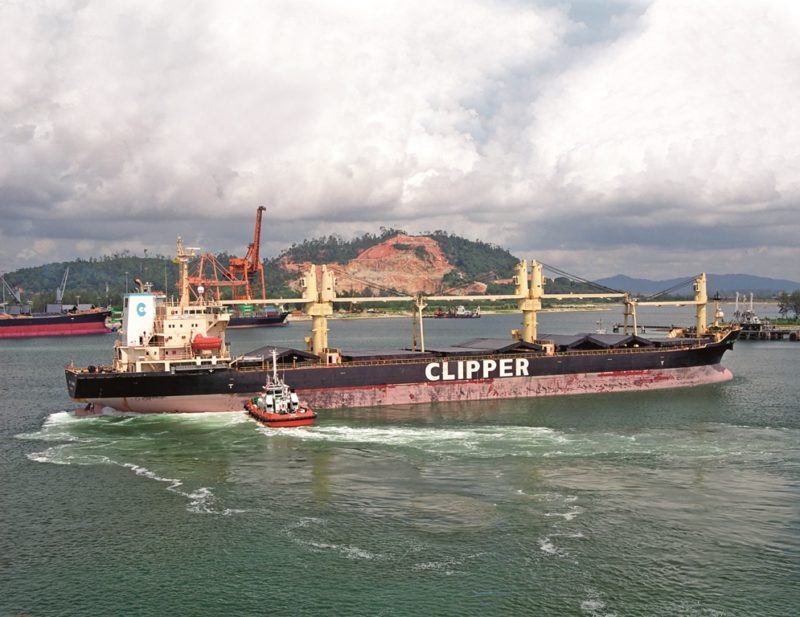
Malaysia has 25 ports in Peninsular Malaysia, 17 in Sabah, and 13 in Sarawak, but only four of these are major ports and all are located in Peninsular Malaysia, and handled over 20 million tonnes of cargo using only 75% of their total handling capacity and only 47.5% of their container capacity in 2014. These four ports are Penang, Port Klang, Johore and Kuantan. I have described both Penang and Port Klang already in Ports of Call in this magazine. The Port of Johore is located at the city of Pasir Gudang in Southern Malaysia opposite the north coast of Singapore Island and was established in 1977. It has the largest Palm Oil Terminal in the world with also multi-purpose, dry bulk, breakbulk and container berths. In 2019, the Port of Johore for the first time since container operations began in 1993 had a throughput of one million TEU of containers, up 10.5% over the previous year.
HISTORY AND CULTURE OF KUANTAN
The Port of Kuantan is a main shipping gateway from the East Coast Economic Region (ECER) of Malaysia to markets in the South East Asean, Asia Pacific and Far East areas. The port offers the shortest, quickest and most direct route between Malaysia and other ports in China, Japan and Taiwan. The city of Kuantan lies 25 kilometres to the south of the port and was officially declared a city in 2020. It is the administrative centre of the State of Pahang and is located at the mouth of the Kuantan river. It is the largest city on the East Coast of Peninsular Malaysia. The Sultan of Pahang officially relocated the administrative centre from Kuala Lipis to Kuantan on 27th August 1955.
The climate of Kuantan is officially ‘Tropical Rainforest’ under the Koppen climate classification. The area experiences two seasons per year, the ‘Dry and Hot’ season and the ‘Rainy’ season. This is a relative definition as the area does not have a truly dry season, but occurs when seasonal south west winds blow in from Sumatra towards the West Coast of Peninsular Malaysia but are blocked by the Titiwangsa Mountain Range. The temperature often reaches 40 degrees Celsius in the ‘Dry and Hot’ season. The ‘Rainy’ season usually occurs between October and March when north east winds bring rain and much cloud to Kuantan. The rainfall is high and flooding of areas can occur near to the Kuantan river and on the road to Sungai Lembing, a former tin mining area. Air pollution with sand and dust blowing in from Sumatra and the West Coast of Peninsular Malaysia can also occur.
The history of Kuantan follows the Chinese empires of Chih-Tu and Pheng-Kheng until it was taken over by the Siamese during the 12th century. A Chinese naval squadron under Admiral Zheng He sailed from China on 8th March 1421 and passed Kuantan on their way to their base at Malacca for exploration and discoveries in the Indian and Antarctic Oceans. Five hundred years later on 10th December 1941, a British naval squadron under Admiral Sir Tom Phillips on the battleship flagship Prince of Wales, accompanied by the battlecruiser Repulse and four destroyers, was annihilated by Japanese dive bombers and torpedo bombers and sunk with the loss of 840 British lives as the age of the battleship was rapidly drawing to a close. Four Japanese planes were shot down and many more damaged by British anti-aircraft guns at a cost of 18 Japanese lives. Force Z had the mission to intercept the Japanese invasion fleet that was about to make an amphibious landing in Northern Malaya. The task force had no air cover or support and failed to find and destroy the main invasion fleet, and on their return to Singapore both capital units were quickly sunk. The attack occurred 61 miles due east of the present day Port of Kuantan, and only three days after the surprise attack by aircraft from five Japanese aircraft carriers on Pearl Harbour at Honolulu.
During the 15th century, Kuantan was ruled by the Malacca Empire, but became an area under the control of the Sultan of Pahang in the 1850s. Fishing and agriculture were the main economic activities until the Chinese tin miners and traders arrived in the 1890s to establish the town of Kuantan and nearby tin mining areas of Sungai Lembing and Gambang. Indian settlers then arrived to begin rubber plantations, with the demographic split of the population based on the Department of Statistics Malaysia now as Malay (78.5%), Chinese (17.9%), Indian (3.3%) and others (0.3%). The Pahang State Mosque (Masjid Negeri) is an imposing building with a blue dome and four tall, white minarets set in a beautiful park. A large reclining Buddha can be found in a cave called the Charah Cave in the limestone mountains on the road to Sungai Lembing around twenty miles from Kuantan. The highest peak of Gunung Tapis can be climbed from the Charah Cave. The traditional foods and crafts of batik, handicrafts, dried and salted fish, timber felling and wood carving, and fishing go back many centuries.
Batik weaving and dyeing is a Malaysian and Indonesian technique of using wax resistant dyeing of cloth that is applied to the whole cloth. Batik is made either by drawing dots or lines on the wax with a spouted tool called a canting, or by printing the wax with a copper stamp called a cap. The applied wax resists dyes and thus allows the artisan to colour selectively by soaking the cloth in one colour, removing the wax with boiling water, and repeating if multiple colours are desired. Intricate patterns can be achieved by this method on very large pieces of cloth.
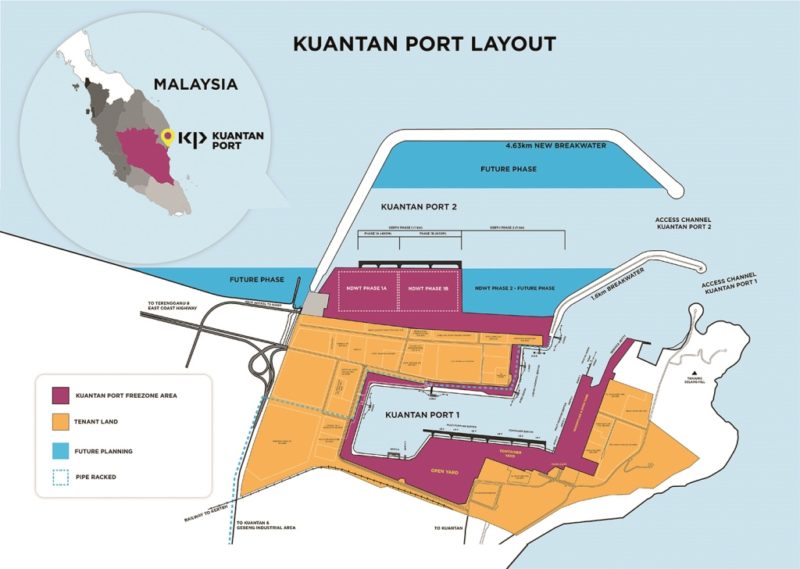
THE MARITIME SILK ROUTE
The Overland Silk Route of Marco Polo connected Venice and Eastern Europe with China, and today the Maritime Silk Route connects Chinese container ports with six Federal Port Authorities of Malaysia, namely Penang, Port Klang, Johore, Kuantan, Malacca and Bintulu and their terminal operators and logistics associations. The Port of Kuantan is located on the east coast of Malaysia around 200 miles north of Singapore on the main East Coast Railway, and a three hour drive due east from Kuala Lumpur, the capital of the country. Kuala Lumpur which has the tall twin towers of the Petronas Building as well as a collection of Victorian architecture that has been preserved, is far greater in size than the modest city of Kuantan with a population of 525,000, the city having doubled its population in the last two decades. Kuantan Airport is located 30 miles away from the Port of Kuantan.
The Port of Kuantan was created by the Government of Malaysia on 1st September 1974, with the construction of the channel into the main terminals begun in 1976. This involved a huge amount of dredging of a muddy bay, with the first two warehouses erected in 1978 and the initial construction of the port was completed in 1979, after a breakwater of 1.6 kilometres in length was completed using concrete and accropod blocks, each weighing ten tonnes with a total of 10,000 blocks dropped into position to form one of the longest breakwaters in South East Asia.
The construction of the new Port of Kuantan was undertaken by the Government of Malaysia in 1976 despite a downturn in the national economy, with coastal shipping at the time transporting petroleum (73.4%), logs and timber (5.7%), cement (10.0%), palm oil (10.0%) and rubber (0.9%). The Port of Kuantan was in partial operation in 1980 and in full operation in 1984, and two years later in 1986 it was handling 278,000 tonnes of coastal cargo out of its maximum capacity of 529,000 tonnes at that time. This capacity rose by an average growth of 5% per annum until 1995, and then ten years later in 2005 it handled 9.411 million tonnes of cargo, which had increased rapidly to 40.030 million tonnes throughput in 2015. There are two dozen cargo berths including three container berths, with the first container ship arrival in 1988, and a container total throughput of 119,100 TEU in 2005, rising to 142,100 TEU in 2010, and 154,250 TEU in 2019.
The Port of Kuantan was privatised in 1998 and today it is owned by a 62% stake by the IJM Corporation Berhad, a public listed company on the Main Bourse of Malaysia, together with a 38% stake held by the Guangxi Beibu Gulf International port group, the 38% stake being sold in September 2013 for US$102 million to the Chinese group. Guangxi Beibu Gulf International also owns the four ports of Qinzhou, Tieshan, Beihai and Fangchenggang, all in Southern China. The Port of Kuantan is the main port of the Federal State of Pahang, and it brings together the best practices of port management in both China and Malaysia with the network of clients from both groups enhancing the capacity of the port. A new deep water terminal costing US$700 million is mostly complete at the time of writing and is described in full later, and increases maximum port capacity up to 52 million tonnes of cargo per year. The Port of Kuantan has been identified in the East Coast Economic Region (ECER) of Malaysia as the main integrated industrial and logistics hub for the State of Pahang.
The Kuantan Port Authority (KPA), also known in the Malay language as Lembaga Pelabuhan Kuantan (LPKTN), is governed by a Board of Directors of five members, with two Senior Managers and a General Manager. The Deputy Minister of Finance of the Government of Malaysia visited the port on 21st May 2020 on a working visit to meet all of the port officials of the various departments, and he also inspected all of the port container berths and was presented with a painting of the area at the end of his visit.
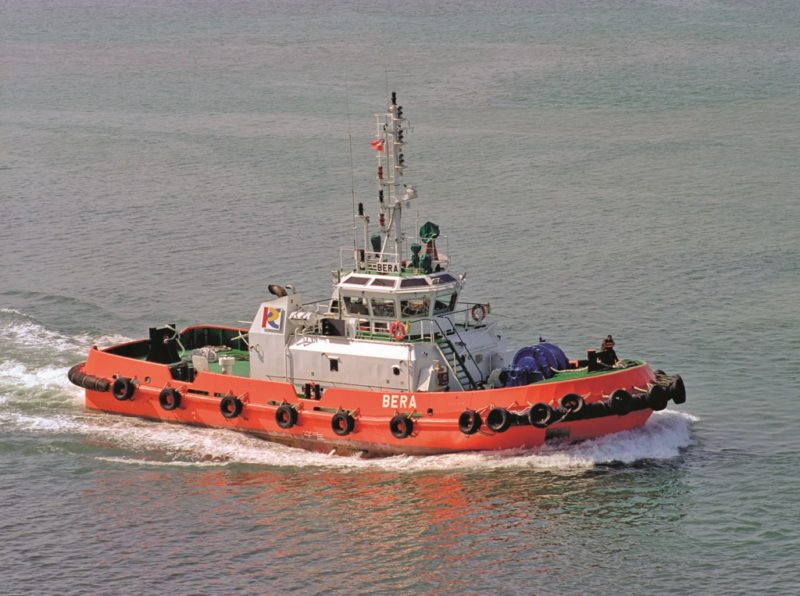
CARGOES AND BERTHS OF THE PORT
The Port of Kuantan is a commercial port located at latitude 3°58′ North, 103°26′ East at the intersection of several shipping lanes in the South China Sea and is located 25 kilometres from the town of Kuantan, the capital of the State of Pahang. The Port of Kuantan is a major gateway for trade in the Asia Pacific region and the ECER (East Coast Economic Region) of Peninsular Malaysia. The Port of Kuantan is situated only a few miles from one of the biggest petrochemical and industrial areas in South East Asia at Gebeng Industrial Estate of 8,400 hectares, just to the south of the port. There is a special bypass road from Gebeng Industrial Estate to the port to avoid jams and ease traffic flow.
There are thirty major companies in production at Gebeng of large amounts of petrochemicals, which are transported by pipeline and railway to eight liquid bulk berths at the port. These are BP Chemicals, Shell Malaysia, BASF Petronas Chemicals, MTBE (Methyl Tertiary Butyl Ether), Polypropylene (Malaysia), Flexsys, Bredero Shaw, Eastman Chemicals, Polyplastics Asia Pacific, Kaneka (Malaysia), Mieco, Mission Biofuels and Biotechnologies, Momentive Speciality Chemicals, KNM, W. R. Grace Speciality Chemicals, Cryovac (Malaysia), Wasco Pipeline Coatings, AMC, FGV Green Energy, FGV Biotechnologies, PK Fertilisers, YAL Resources Holdings, Enten Oils and Fats, Petron Fuel International, CSA Chemicals, UPC Chemicals, Asta Chemicals, RP Chemicals, Toray Resins, Felda Biodiesel Global Ventures (Downstream), FPG Oleochemicals, Lynas (Malaysia) and other petrochemical companies.
MTBE (Methyl Tertiary Butyl Ether) is an advanced ‘anti-knock’ additive to gasoline to decrease engine wear and is blended into gasoline to increase knock resistance and reduce unwanted poisonous emissions. It is a volatile, colourless and flammable liquid that is sparingly soluble in water. MTBE is produced only at Zhejiang in China, Malaysia and by Saramco (Saudi Aramco) in Saudi Arabia and is used throughout the world as a useful gasoline additive that lowers poisonous emissions. It is legally used in most but all of the States of the United States of America, those that do not blend it with gasoline use for industrial uses only.
Petronas Chemicals and its German partner BASF have a large capacity Ethyl Hexanoic Acid plant at Gebeng with an annual capacity of 30,000 tonnes per annum. The plant is a 60/40 joint venture (60% Petronas, 40% BASF) and is the largest acid plant of its kind in South East Asia, production having started in the second quarter of 2016. BASF currently also operates a large Ethyl Hexanoic plant in Ludwigshafen in Germany, with the acid used in the production of synthetic lubricants as well as oil additives, automotive coolants, metal salts for paint dryers, plasticisers, stabilisers, catalysts and similar related products.
Felda Global Ventures (Downstream) currently operates a biodiesel plant at Gebeng with a capacity of 10,000 tonnes of biodiesel per year. Gebeng Industrial Zone also has several steel industries, palm oil mills, polymer plants, oil, gas and energy production, coal mining, metal working, concrete manufacture, concrete ducting, timber and wood processing, detergent production, oxygen and industrial gas production, and a rare earth processing facility for the International Atomic Energy Authority (IAEA). Australian rare earth ores are imported at the Port of Kuantan and transported in large cylinders by rail to Gebeng Industrial Park. The twin rivers of Sungai Tunggik and Sungai Balok run over most of the area, with Tunggik mainly affected by industrial pollution and surface water contamination.
There are more long term clients of the Port of Kuantan at Pahang Technology Park in Gambang with Pahang Halal Food, Halal Industrial Products and Gelnas Gelatine Products, and at Telok Kalong Industries at Kemaman Industrial Port in the State of Ternengganu to the north of the Port of Kuantan with Tioxide (Malaysia), Pacific Iron Products and Perwaja Steel Products. The cyber and automotive industries are also long term clients of the Port of Kuantan.
The oils and liquid petrochemicals are exported from the Port of Kuantan at four liquid berths and four liquid chemical berths, and the other Gebeng Industrial Park products arrive by rail and road for export from the multipurpose berths. The import and export dry bulk cargoes are currently carried in seven hold bulkers in the range up to 85,000 dwt (Kamsarmax). The chemical tankers range in size from 7,500 dwt to 50,000 dwt. General break bulk cargo trades are carried on in multi purpose ships. The port berths (berita in Malay) are as follows:-
NEW DEEPWATER TERMINAL (NDWT)
1A Dry Bulk of length 400 metres, alongside depth of 14.5 metres
1B Dry Bulk of length 600 metres, alongside depth of 14.5 metres
2A Container berth under construction of length 500 metres, alongside depth of 18.0 metres
2B Container berth under construction of length 500 metres, alongside depth of 18.0 metres
LIQUID BULK
Palm Oil 1 Berth of length 240 metres, alongside depth of 8.0 metres
Palm Oil 2 Berth of length 150 metres, alongside depth of 11.2 metres
Palm Oil 3 Berth of length 240 metres, alongside depth of 11.2 metres
Mineral Oil Berth of length 150 metres, alongside depth of 8.0 metres
LIQUID CHEMICALS
Liquid Chemical 1 Berth of length 240 metres, alongside depth of 11.2 metres
Liquid Chemical 2 Berth of length 240 metres, alongside depth of 11.2 metres
Liquid Chemical 3 Berth of length 240 metres, alongside depth of 11.2 metres
MTBE Export Berth of length 240 metres, alongside depth of 11.2 metres
CONTAINERS
Container Berth 1 of length 200 metres, alongside depth of 11.2 metres
Container Berth 2 of length 200 metres, alongside depth of 11.2 metres
Container Berth 3 of length 200 metres, alongside depth of 11.2 metres
MULTI-PURPOSE BERTHS
Multipurpose 1 of length 725 metres, alongside depth of 11.2 metres
Multipurpose 2 of length 725 metres, alongside depth of 11.2 metres
Multipurpose 3 of length 725 metres, alongside depth of 11.2 metres
Multipurpose 4 of length 725 metres, alongside depth of 11.2 metres
CB4 of length 200 metres, alongside
depth of 11.2 metres
CB5 of length 200 metres, alongside
depth of 11.2 metres
CB6 of length 200 metres, alongside
depth of 11.2 metres
Service Jetty of length 140 metres, alongside depth of 4.0 metres
Pier 5 of length 180 metres, alongside depth of 5.0 metres
Pier 6 of length 120 metres, alongside depth of 7.0 metres
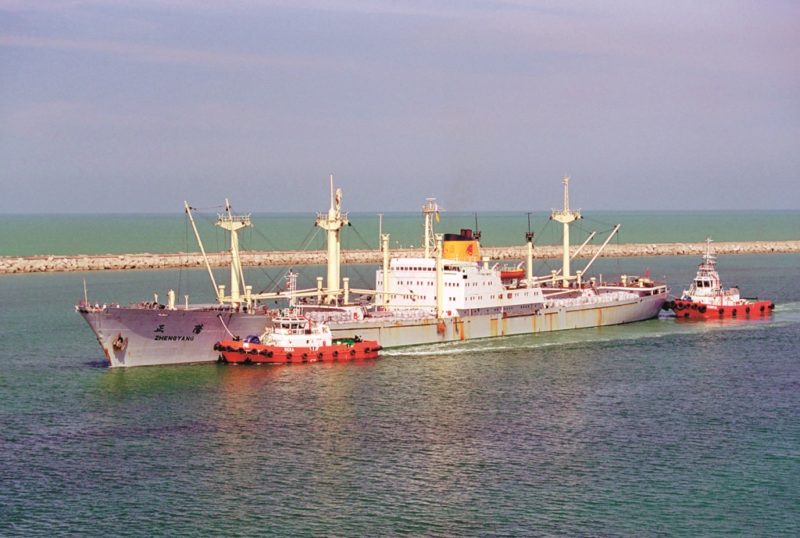
PORT LIMITS, LAND AREAS AND NEW DEEP WATER TERMINAL
The port limits to seaward are within a rectangular area that is bounded by the foreshore and the southern bank of Sungai Kuantan shore and bank within fifty yards of the high water mark. The port limit then runs northwards along the foreshore and back to the boundary pillars, including all of the piers, jetties, landing places, wharves, quays, docks and other port works.
Whether the limit is within or without the line of the high water mark, and any positions on the shore, all are subject to the rights of private owners. The Port of Kuantan has a land area of 650 acres and is zoned according to use. An area of 315 acres has been leased to companies in the petrochemical, chemical and other companies seeking a foothold in the new and expanding port. Kuantan Flour Mill, Cargill Palm Oil Products, Union Harvest, Maxis Broadband, and Golden Century Synergy are some of the non petrochemical companies. The Royal Malaysian Navy has a base at the outward end of the main channel near to the port service jetty, and is on the port side of shipping entering the main channel. There is public access to the south side of the Royal Malaysian Navy base.
The New Deep Water Terminal (NDWT) has been built to seaward of the existing channel and berths, and is enclosed by a very long breakwater of 4.63 kilometres in length and formed by the dropping of concrete and accropod blocks, each weighing ten tonnes with a total of 20,000 blocks dropped into position to form one of the longest breakwaters in South East Asia. The NDWT has been built by a public private partnership project between the Government of Malaysia and Kuantan Port Consortium and was approved in June 2015.
The new terminal was developed in two phases, Phase 1 and Phase 2, at a total cost of around US$808 million. Dredging of the harbour area and navigation channel, 19.88 hectares of land reclamation works, construction of new berths and cargo storage yards, as well as the provision of infrastructure facilities and utilities accounted for the bulk of the cost.
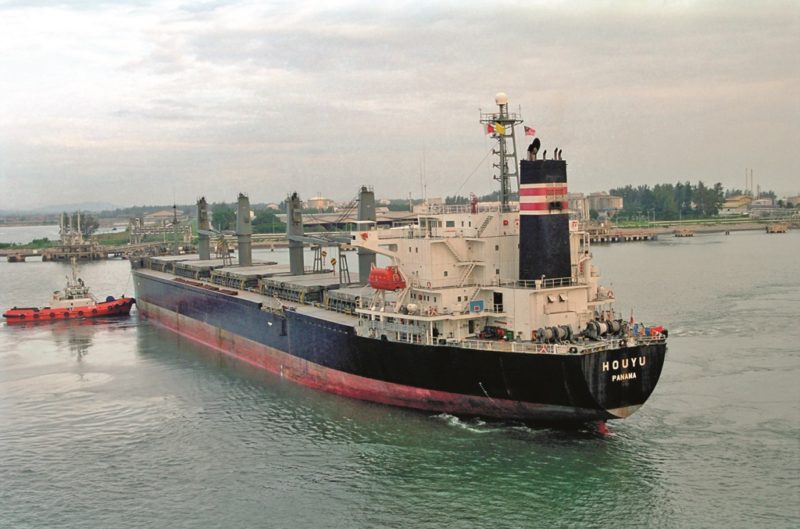
The new deep water terminal is sheltered from the North East Monsoon winds by the long breakwater. The phases were :-
Phase 1A gave a basin of 16.0 metres alongside depth, a 400 metre berth for bulk carriers up to 160,000 dwt, and 20 hectares of adjacent cargo yard. This phase was in operation in early 2018.
Phase 1B gave a basin of 16.0 metres alongside depth, a 600 metre berth for bulk carriers up to 160,000 dwt, and 25 hectares of adjacent cargo yard. This phase was in operation by the end of 2018.
Phase 2A and 2B are for container ship berths and are currently at the time of writing under construction. The container ship berths are both of 500 metres in length with an alongside depth of 18.0 metres, and there are 47 hectares of container yards.
The port has four tugs of 3,200 bhp, named Pekan, Kuantan, Bera and KST 44, two pilot boats of 1,100 bhp, and two mooring boats of 130 bhp, and other tugs may be called to help out at the port. Port equipment includes two ship unloaders with a maximum capacity of 2,000 tonnes per hour, two stacker reclaimers with a maximum capacity of 2,000 tonnes per hour for the reclaimers and 4,000 tonnes per hour for the stackers, conveyor belts with a maximum capacity of 4,000 tonnes per hour, mobile cranes, front end loaders, trailers, container crates, container gantry cranes, rubber tyred cranes, forklifts, level luffing cranes, portable hoppers and other mobile dockside equipment. The length of the entire port is 4.5 kilometres on the landward side.

Transit warehouses occupy a total ground area of 29,180 square metres, another seven warehouses are of 32,500 square metres, and with the open storage yards give ample storage areas. The Class 2 and Class 3 Dangerous Goods Yard can hold 180 TEU of containers with dangerous goods during 2019 amounting to a total of 1,282 declarations.

The Intermodal Container Station and the Onward Container Freight Station occupy 9,600 square metres of land, the latter is used for the destuffing and restuffing of containers and for the temporary storage of stuffed and unstuffed containers. There is ample long term storage for 1,750 TEU of containers plus 120 reefer plugs for refrigerated storage at the Freight Station, and the work is carried out by KP Depot Services. The container berths use four large Fixed Gantry Cranes, six Rubber Tyred Gantry Cranes, three Reach Stackers of 40 tonnes capacity, and one Level Luffing Crane of 40 tonnes sling capacity and 16 tonnes grab capacity. A current maximum container throughput of 400,000 TEU per year will be increased by the new Phase 2A and 2B container berths in the Deep Water Terminal to 600,000 TEU per year. Breakbulk cargo consists of steel pipes and plates, heavy cargo, sawn timber, plywood, heavy lift project cargo, and other commodities. The services offered by the Port of Kuantan are as follows:-
CARGO SERVICES
Breakbulk, dry bulk and liquid bulk cargoes
Dangerous goods declarations
Destuffing and restuffing of containers
Repair of broken equipment when servicing dry and liquid cargoes
Common user Tank Farm operated by Chem Station and Felda Global Ventures specifically to handle grades of edible and vegetable oils
MARINE SERVICES
Port Control and Navigation services
Demurrage penalty fees for non movement of cargo off berth
Delay rectifications
Pilfering enforcement
SUPPORT SERVICES
Stevedoring
Bunkering by pipeline or tanker truck
Bunkering by STS (Ship to Ship)
Tallying of cargo
STS Cargo operations
Waste disposal
Equipment Supply
Diving
Fumigation
Lay-up of shipping
Lashing and packing of cargo
PORT FREE ZONE
The Port Free Zone was created on 30th January 2019 to include the growing amount of transhipment cargo instead of only import and export functions of the port. This transhipment cargo will continue to increase as the Port of Kuantan is strategically placed on the Maritime Silk Route that links China with other South East Asean countries and served by the new generation of giant container ships. Singapore is only one day steaming away, Hong Kong four days, Taiwan nine days, Tokyo eleven days, Middle East twenty-one days, Mediterranean ports twenty-five days, Northern Europe twenty-eight days and West Coast U.S.A. ports thirty days.
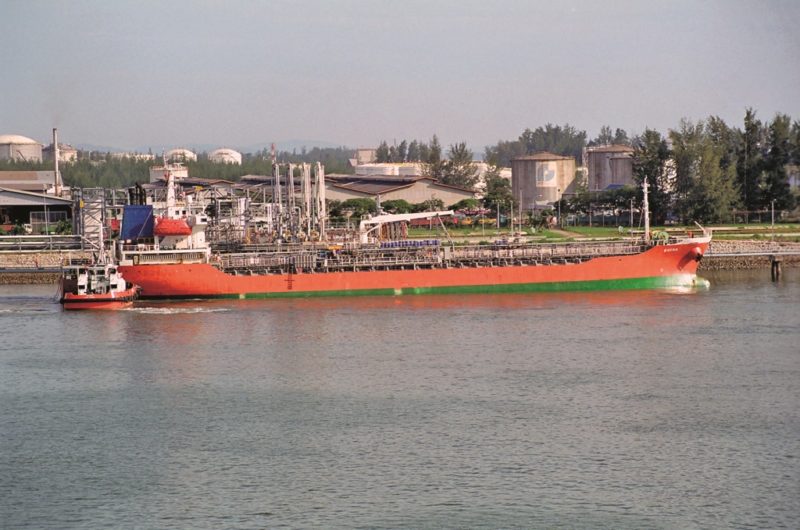
ACCESS ROADS
Port upgrades on road access have been completed in two phases, the first phase involved a new stretch of 400 metres of road, with the second phase involving the completion of another 600 metres of road, both completed by mid 2019. This increased the amount of cargo that the port receives today and will receive in the future, with the two new roads connecting to the East Coast Expressway and other highways by September 2019. A dedicated road for the transport of bauxite from Bukit Goh to the Port of Kuantan was completed in March 2016 after the clearance of much forest and excavation. This also prevented the possibility of pollution in residential areas on this new five kilometre stretch of road along which the bauxite is transported for export.
The new roads will help to make the Port of Kuantan a vibrant logistics hub in the South East Asean region, and the road upgrades have continued to receive positive feedback and interest from both domestic and foreign investors in China, Japan and Taiwan and further afield. The Port of Kuantan is near the Malaysia-China Kuantan Industrial Park, the first in the country to receive national status, and also the Kuantan Integrated Biopark.
SHIPPING OF THE PORT OF KUANTAN
INTERNATIONAL MARITIME CARRIERS (IMC)
The shipping magnate Frank Tsao (1925-2019) founded one of the largest shipowning groups in the world, the International Maritime Carriers (IMC) in 1966. He was educated at St. John’s University in Shanghai, and his father and grandfather were bankers on the Bund at Shanghai, but the family lost everything in World War II and the subsequent civil war and fled Shanghai for Hong Kong in 1949 just weeks before the Red Army marched in. The first shipping company had the grand title in 1949 of the co-founded Great Southern Steamship Co. Ltd. with a single engines ‘midships coastal trader. A wide range of cargoes was then found for general cargo, bulkers and tankers bought from Greek owners, with some old tankers converted into bulkers to give a fleet of ten ships in 1973 each of up to 33,700 dwt, all with ‘Maritime’ prefixes to their names.
Frank Tsao participated with other shipping magnates in the formation in 1968 of Malaysia International Shipping Corporation (MISC), the national line of Malaysia. Subsequently, Aurora Tankers was set up in Malaysia in 1994 to load export cargoes from the Port of Kuantan. He also founded the first shipyard in Malaysia and its first seafarers training centre, as well as developing new technology parks and exhibition centres in the country. An Asian shipping pool, Transglobal Bulkers, was formed in the early 1970s with MISC and Brostrom of Sweden, and IMC Holdings Ltd. was publicly quoted on the Hong Kong Stock Exchange in 1972. Frank Tsao invested in 1978 with a minority interest in the United Thai Shipping Corporation (UTSC), the national line of Thailand and took it over in 1987.
United Thai Shipping Corporation (UTSC) had been formed in 1976 to serve the Thai Government vision of founding a Thai national flag carrier and began Europe/S. E. Asia/U.S.A. conventional liner services. Services were expanded to South and West Africa, the Middle East and the Far East with owned general cargo ships such as Yala Navee of 19,350 dwt and built in 1976 by the Kurushima Dockyard at Onishi and purchased second hand in 1996 as Kota Jati from Pacific International Lines (PIL). The United Shipyard and Engineering Ltd. (UTSE) was established in 1990 at Laem Chabang Port, with two floating docks for repair work, one for ships up to 50,000 dwt and the other for ships up to 140,000 dwt, and has also completed small general cargo ships of up to 3,000 grt. This shipyard completed a record 2,000 repair contracts at Laem Chabang in 2015 after 25 years of operation.
United Thai Logistics Co. Ltd. (UTLC) and United Thai Warehouse Co. Ltd. (UTWC) were formed as joint ventures in 1994. Unithai Container Terminal began operations in Samut Prakan province in 1997, and offshore companies had been formed by Millennium year. The ‘UniGear’ service joint venture with GearBulk of Norway began a South African service in 2001, with Panamax bulk carriers owned from a year later. Joint ventures were later formed with Myanmar, Vietnam and Korean shipping companies. The Unithai logo of three seagulls in the red and blue colours of the Thai national flag represents worldwide services, both westwards and eastwards.
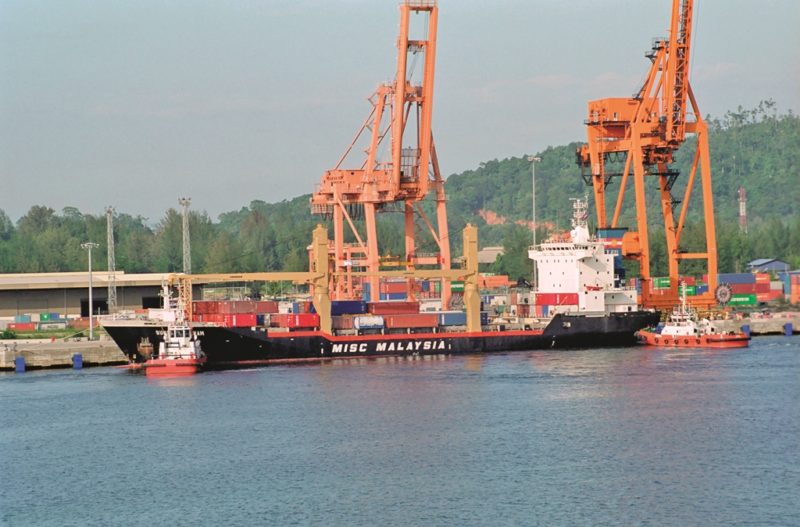
Frank Tsao and IMC converted a bulk carrier in 1985 into a cement storage and unloading facility at Port Klang, moored for the distribution of cement throughout the State of Kedah, and with another Far East Cement Terminal opened in Hong Kong. Lifelines Produce Co. Ltd. was set up in Thailand in 1985 for the commercial farming of fruit and vegetables for domestic and export markets. In 1991, the IMC corporate headquarters was moved to Singapore from Hong Kong, and three pioneering dry bulker pools were set up as IMC Transworld (for Panamaxes), IMC Transocean Grabpool (for Handymaxes), and IMC Transasia (for Handysizes). A freight forwarding company was set up in 1996 in Qingdao by the IMC Investment Company in China and COSCO Logistics Qingdao.
The IMC fleet in 1998 comprised forty general cargo ships, bulkers and container ships of up to Panamax size, most having ‘Maritime’ prefixes to their names. The Head Office was in the Suntec City Tower exhibition centre and shopping mall, with the IMC directors and managers being mostly Chinese. The holding company of IMC Holdings Ltd. was privatised by the Tsao family in 2002. A diversification into the oil and gas industry was made in 2003 to form Cuel Engineering and Fabrication Services, jointly with a Thai company that was later taken over by Chevron Oil. A joint venture was formed with Modec, a leading owner of Floating Production Storage Unloading (FPSO) vessels to build a jointly owned FPSO. A floating coal loading facility at Kalimantan in Indonesia was designed by IMC staff to service the entire bulk commodity chain using barges and floating cranes. Investments were made in Australian mines producing iron ore, coal, nickel and gold, as well as in Australian oil and gas production with Horizon Oil. A further bulker company in Singapore was set up in 2006 as Oriental Bulk Shipping, as well as jointly owned ship repair yards in China. The largest iron ore transhipper in the world, Ore Fabrica owned by Vale of Brazil, was managed from 2012.
Frank Tsao died on 12th August 2019 at his home in Singapore, having been made an honorary citizen of Singapore in 2008 and taken Malaysian Chinese Nationality. He is remembered by people in Singapore for his generous donations to charity, as well as one million dollars he contributed towards the funds for the new Singapore National University for Maritime Studies. He was the last of a group of Chinese shipping tycoons of the era before World War II to have risen to world prominence from Hong Kong. The current IMC shipping operations are:-
Aurora Tankers on US Gulf to Far East and return, and Middle East Gulf to Far East and return, tankers have ‘Maritime’ prefixes to their names e.g. Maritime Horizon of 56,850 dwt built in 2016 and Maritime Vanessa of 44,400 dwt built in 2002.
Dry Bulk Shipping of coal, iron ore, alumina, bauxite, aggregates, steel products, cement, clinker, manganese ore etc.
Liner Services on Far East to Africa using heavy lift multi purpose vessels transporting offshore wind turbines, project cargo, steel products, bagged chemicals and rolling stocks. A joint service to South Africa from Thailand and Vietnam in a pool with GearBulk and Unithai.
Unithai Shipping and Logistics.
Indonesia Industrial Business Unit (ILBU) for transhipment operations with 39 tug and barge units, with barge capacity up to 9,500 tonnes.
IMC Shipping and Offshore Tech Services for newbuilding and conversion projects.
Parcel tanker operations in coastal tankers of 7,000 dwt between China, Korea and South East Asia with petrochemicals from the Port of Kuantan.
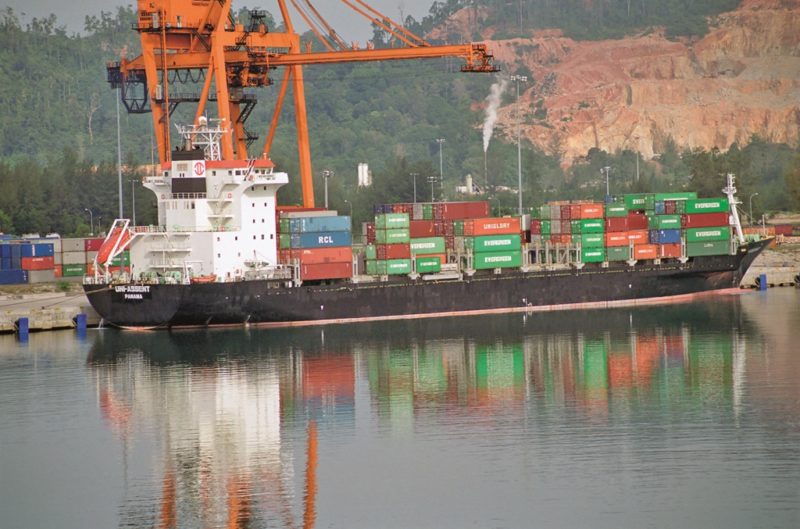
FEEDER CONTAINER SERVICES
The Port of Kuantan container services are operated by ten shipping companies with large and small feeder container ships of between 1,000 TEU and 2,500 TEU capacity sailing on many routes around South East Asia. These shipping companies are:-
Evergreen Line of Taiwan have a very large fleet of giant container ships operating on worldwide routes, and chartered eleven giant container ships of 18,000 TEU from Shoei Kaisan Kaisha of Japan that entered service on the Far East to Europe service during 2018/19. Smaller Evergreen container ships operate on the Far East Africa Express (FAX) service, and on Intra South East Asia routes. Evergreen Line began feeder services to and from Malaysia in 1979, and to and from the Port of Kuantan in 1988, and on 1st January 2000 established Evergreen (Malaysia) Sdn Bhd with two routes, including a weekly Thailand to Malaysia and Indonesia (TMI) string using two ships, and a weekly Vietnam to Malaysia and Indonesia (VMI) string using two ships. The owned vessel Berjasa of 350 TEU capacity was used up to 2003 when the larger chartered container ship Cape Norviega of 1,510 TEU capacity taken on a twelve year charter, having been built as Justice Container in 1998 at Onomichi, and sold on to Wan Hai Lines in 2015. Ever Apex of 1,164 TEU and Uni-Concord of 1,038 TEU capacity are the current two ships used on the TMI and VMI strings.
Pacific International Lines (PIL) had a large fleet of 112 container ships of 0.35 million TEU capacity in 2018, and 130 container ships of 0.411 million TEU capacity in 2020, a rapid advance from being incorporated in Singapore in 1967. PIL has developed from a coastal South East Asia operator into the largest shipowner serving this region, and also serves the Asia to Europe route, Middle East, Oceania and Latin America and serves over 500 ports worldwide. A twice weekly services operates to and from the Port of Kuantan around the region and to Singapore with the feeder container ships Kota Tampan and Kota Tenaga of 756 TEU capacity and 10,600 dwt, and the slightly larger Kota Rancak of 945 TEU capacity and 13,260 dwt. This trio all have service speeds of 14.5 knots.
Mariana Express Lines Ltd. (MELL) was established in 1997 with regular sailings in the Asia Pacific region and currently has an extensive feeder container network in China, South East Asia, Japan, Australia and the Pacific islands, with Hong Kong and Kaohsiung as hubs. The fleet includes the feeder container ship MELL Sudong of 16,838 dwt and employed on the Australian and South Pacific islands strings.
Advance Container Lines (ACL) was established in 1995 to provide a dedicated network of feeder container services in the South East Asian ports of Malaysia, Indonesia, Thailand, Myanmar, Vietnam, Philippines and also to India and Bangladesh. ACL operates a fleet of feeder container ships in the range from 200 TEU to 1,200 TEU capacity and serving thirty ports.
SITC Line was set up in 2001 and is based in Hong Kong as SITC International Holdings Co. Ltd., and now operates a large fleet of small feeder container ships on routes between China, Malaysia, Japan, Korea, Taiwan, Hong Kong, Vietnam, Thailand, Philippines, Indonesia, Singapore and Brunei. SITC Inchon is one of these vessels in the range from 847 to 1,265 TEU capacity with an average age of 7.5 years, all of the fleet having blue hulls and blue funnels with a central white band. The fleet carried 2.483 million TEU in 2018, with container depots owned in Qingdao, Shanghai, Ningbo, Tianjin, Dalian, Haiphong and Ho Chi Minh City for clients such as Tsingtao Beer, Damco Logistics, Singamas and Hisense.
Malaysia Trade and Transport (MTT) uses a number of feeder container ships e.g. MTT Saisunee of 1,200 TEU capacity and 160 feet overall length with a green hull on a regular service from the Chaophraya river in Thailand to the Port of Kuantan.
Regional Container Line (RCL) is based in Thailand and has forty years of shipping experience since formation in 1979 for a service from Bangkok to Singapore. A large fleet of feeder and deep sea container ships in the range from 300 TEU up to 7,000 TEU capacity operates on routes that include Malaysian ports to the Middle East and the Port of Kuantan to Indonesia. The Port of Kuantan agent is Liraship Agency Sendirian Berhad.
X-Press Feeders was formed in 1972 and is one of the largest independent common feeder carrier container lines in the world. A fleet of 110 owned and chartered container ships, with 43 owned and 67 chartered in, cover all of the major global container transhipment hubs throughout South East Asia, Africa, Caribbean, Latin America, Europe, Mediterranean and Middle East ports. The annual container throughput in 2019 was 5.6 MTEU carried on ninety worldwide services.
Bengal Tiger Line was formed in 1986 in India and moved to Singapore at the start of 2009 when it was acquired by a Singapore investment company. It has operated as a common feeder container carrier from its roots in the Bay of Bengal, but now carries cargoes in a wider area from the Far East to the Persian Gulf. The fleet are in the range from 1,000 to 5,680 TEU capacity and carried almost one million TEU during 2020.
Q-Express Line (QEL) carries containers and breakbulk cargo in South East Asia including the Port of Kuantan, and also has freight forwarding, ship agency, port services, and heavy and project cargo in its portfolio. There are several container shipping agencies and freight forwarding companies resident in the port e.g. Pacific Selatan Agency, Gateway Shipping Services, and QEL Shipping Services. Pacific Selatan Agency uses a fixed weekly service into the Port of Kuantan and East/West Malaysian ports on container ships, and provision is also made for non containerised and out of gauge (OOG) cargo, and tug and barge cargoes.
THORESEN GROUP
Thoresen & Company (Bangkok) Ltd. was established in Hong Kong in 1904 as a shipping agency for Norwegian shipping companies on the coast of China, and Asian businesses trading between China and Siam, with a branch office established in Bangkok in 1937. The agency work grew and their first owned ship, Hai Lee of 15,865 dwt, with their classic funnel colours of long, vertical blue, white and red stripes on a black funnel, was purchased in 1985 from Norwegian Asia Line, for liner services to Far East ports such as Yokohama and for the import of sugar cargoes from Port Louis in Mauritius. Semi container liner services operated from Thailand to Japan, South Korea, East Malaysia and Kuantan, United Arab Emirates (UAE), Saudi Arabia, India and Pakistan between 1990 and 2010. The owned fleet in 1998 was two dozen strong included the multi-purpose sisters Thor Sailor, Thor Sea, Thor Skipper, Thor Sky, Thor Spirit, Thor Star and Thor Sun of 16,250 dwt, and expanded from 25 to 33 vessels in 2003, and 40 vessels in 2005, but was trimmed back to fifteen vessels in 2011. In 2011, Thoresen Shipping transported in excess of eight million tonnes of cargo with around 670 port calls.
Currently, the Thoresen fleet stands at two dozen owned bulkers of up to 65,000 dwt, including four open hatch bulkers with box shaped holds of up to 54,880 dwt, and forty bulkers on time charter. This bulker fleet regularly arriving in the Port of Kuantan continues the shipping business originally founded by a member of the Norwegian Thoresen family. Thor Mercury of 55,682 dwt arrived in the Port of Kuantan in January 2021, having been purchased from Italian owners as Medi Chennai in January 2014. As a general rule, the cargoes carried are very large amounts of fertilisers, agricultural products, and forestry products with full logging capability, paper, pulp, scrap metals, chemicals, ore concentrates, sugar and general cargoes. The fleet operates on long term Contracts of Affreightment, time charters and voyage charters at ‘spot’ freight rates. Project cargo including wind turbine blades, towers, and nacelles, steel pipes, plates, coils and ingots are also transported.
The Thoresen Group is one of the largest groups within the Thai shipping sector, the central company is Thoresen Thai Agencies PLC (TTA), a holding company both for shipping and maritime services. The group has expanded its horizons into the Atlantic and world bulk trades with the opening of a commercial chartering branch office in Copenhagen in 2013, followed by Cape Town in 2014, Dubai in 2015, and London in 2016. Shipping services now operated are ship agencies, stevedoring, ship broking, ship maintenance and repairs, marine communications technology, marine insurance, offshore services with a 51% stake in three offshore supply vessels operating in the Gulf of Thailand acquired in the early part of the new millennium.
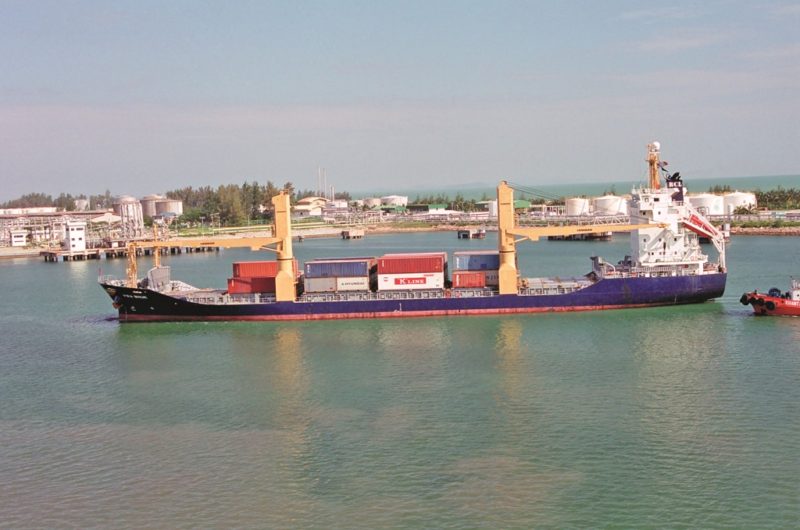
POSTSCRIPT
During a period of only four decades, the Port of Kuantan has grown rapidly from a zero start up position into a major port handling over 40 million tonnes of cargo per year. The construction of the inner harbour and a new deep water harbour on the seaward side of the inner harbour has been on a grand scale at enormous expense. The dredging, land reclamation, and civil engineering workers that have worked hard to create the port with two entrance channels to the two harbours are to be greatly praised for their efforts. This large area port deserves its position as the only fully accredited and identified port and logistics hub on the East Coast Economic Region area of Malaysia, and is a very great credit to the Government and the port managers and departmental staff. The first cruise ship arrived in the port in 1986, this was Cruise Muhibbah, the former DFDS Prinz Oberon built in 1970, which was sold in 1984 and renamed Nordic Sun, and sold again in 1986 to Perbadanan National Shipping Lines (PNSL), Malaysia and renamed as Cruise Muhibbah. After service on the Irish Sea for B + I Line as Munster, she arrived in the Tyne in August 1997 as Ambassador II to be converted into a casino ship, but suffered a severe fire that delayed her completion until September 1998 for short Florida casino cruises. She was broken up in the USA in 2011.
The signing of land leases at the end of 2017 for the construction of an oil refinery for New Ocean Energy (Malaysia) Sdn Bhd with an annual production of 3.5 million tonnes was another milestone in the expansion of the port. A tank farm will serve as a storage depot for entreport trade purposes, and a blending plant for the various grades of oil produced will also be built. This 60 acre refinery will use the existing and new deep water harbour berths, as well as having extra storage tanks for the import and export of crude oil and oil products. The construction will be in two phases and last 3.5 years after the go-ahead for the building of the refinery was given in August 2020 at a cost of US$1.2 Billion. This new refinery will naturally help to promote the nearby petrochemical and oil industries of the Gebeng Industrial Park.

A good comparison of this new port with its abundance of nearby petrochemical industries is with the Port of Teesside. However, the Port of Kuantan has developed very rapidly in only forty years, whereas the Port of Teesside has matured in the longer timeframe of 160 years. The port is being continually improved e.g. the construction at the end of 2019 of a 12 kilometre tubular enclosed conveyor belt system from the new deep water terminal to the Alliance Steel Sendirian Berhad (ASSB) plant located at the Malaysia China Kuantan Industrial Park (MCKIP) with a transfer rate of 4,000 tonnes per hour of iron ore and free from air pollution.




Comments
Sorry, comments are closed for this item